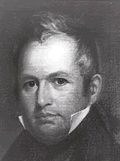| |||||||||||||||||
| |||||||||||||||||
 County Results Wolf: 50-60% 60-70% 70-80% 80-90% 90-100% Ritner: 50-60% 60-70% | |||||||||||||||||
| |||||||||||||||||
The 1832 Pennsylvania gubernatorial election occurred on October 9, 1832. Incumbent Governor George Wolf, a Democrat, defeated Anti-Masonic candidate Joseph Ritner to win re-election.


